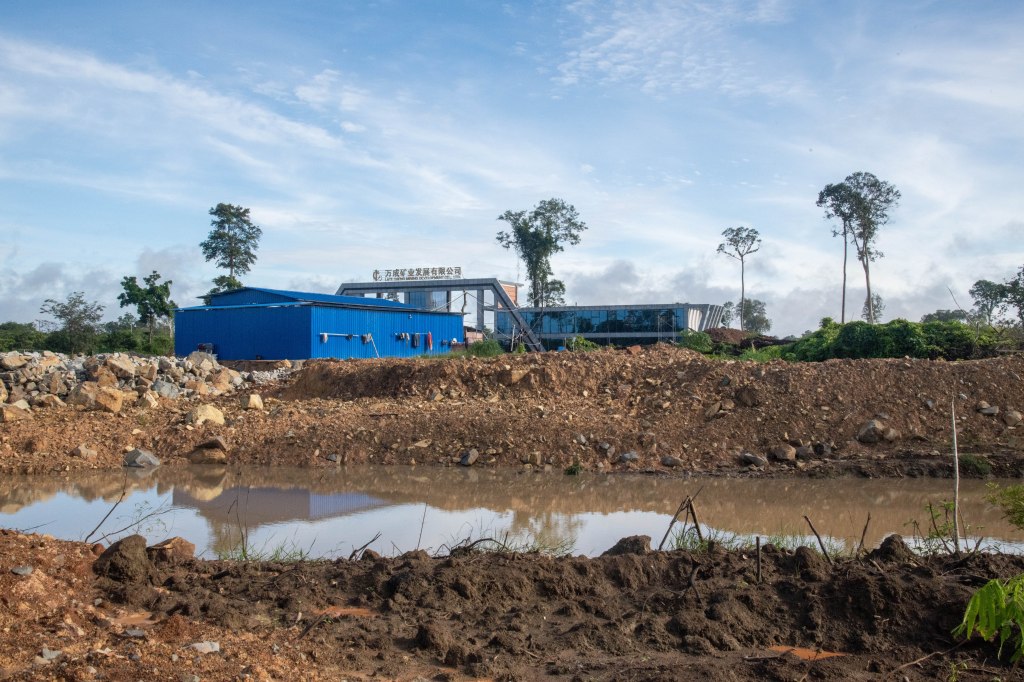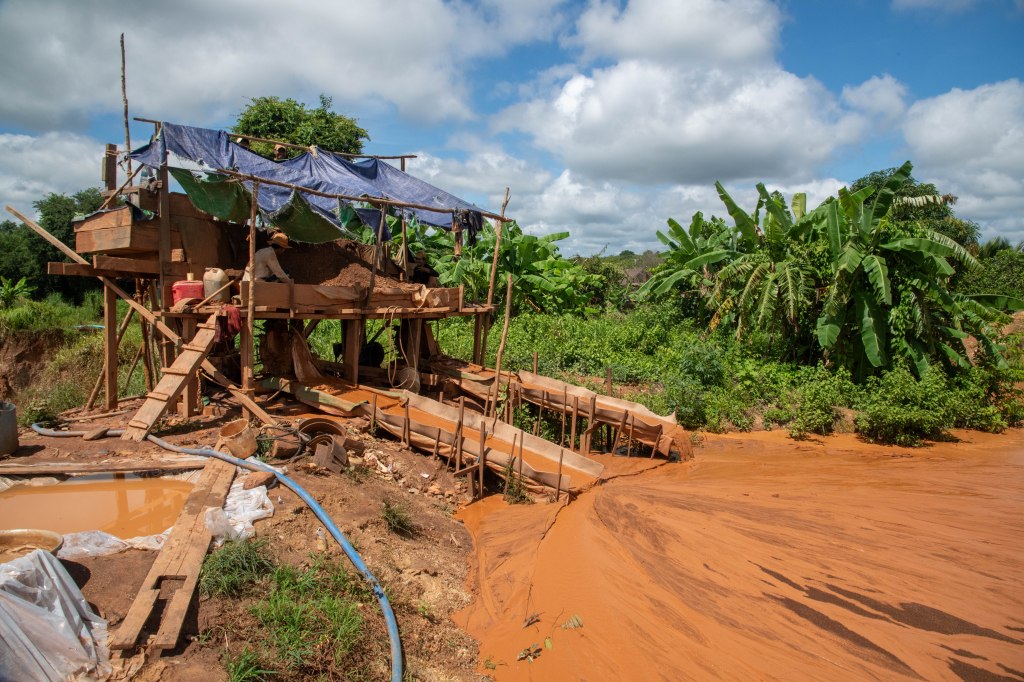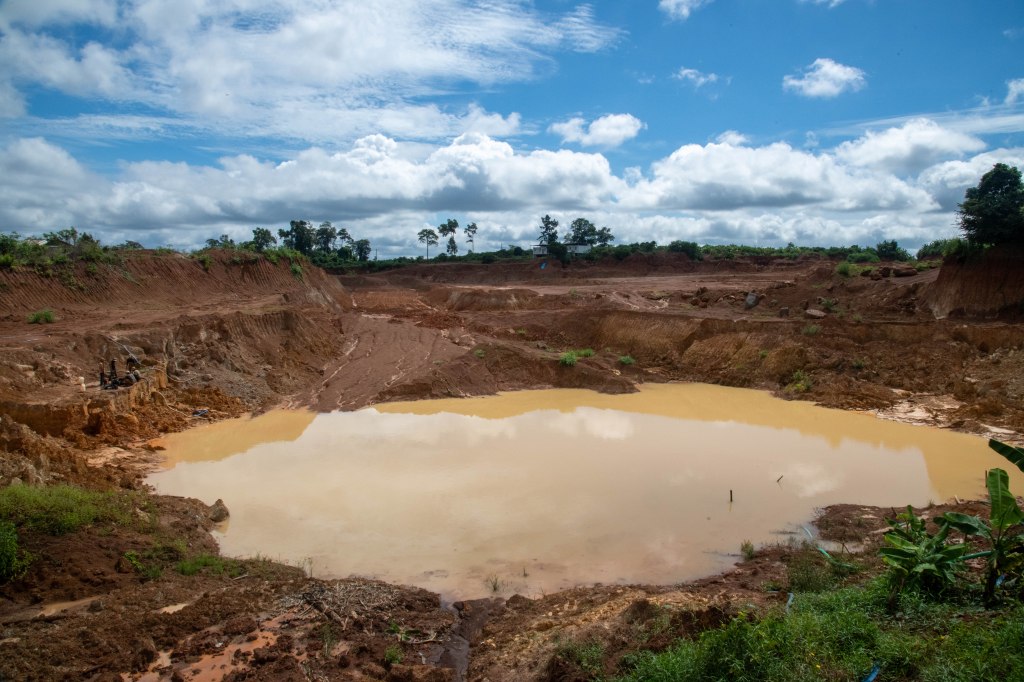Originally published by CamboJA on 20 October 2023 3:19 PM ICT by Andrew Califf, Seoung Nimol and Hel Komsan

Snang An, Kampong Thom – Dead fish and black water ran through the Por Roung river last year due to contamination upstream from an industrial Chinese-owned mine, residents of Snang An village say. They brought their concerns to provincial authorities and were themselves blamed for the pollution.
One year later, these issues have not been formally resolved, more than ten community members told CamboJA. Since 2021, Late Cheng mine has operated a concession within Prey Lang Wildlife Sanctuary, one of Cambodia’s largest and most biodiverse protected areas, allegedly polluting the river and more recently diverting another waterway flowing out of Prey Lang’s core zone. Re-routing the water and other aspects of the mine’s expansion could severely damage the ecosystem, conservation activists and researchers warn.
“Allowing a destructive big gold mine in the middle of a protected area is already totally irresponsible,” says Marcus Hardtke, a conservation activist with more than 20 years of experience in Cambodia. “If it turns out that this mine has been diverting the streams in the area, the main arteries of that forest ecosystem for their greedy purposes, it would also show a complete lack of oversight and control by the authorities in charge.”
Danger of Cyanide Spills

Satellite imagery shows that as the mining expanded, excavators cut a straight channel directing water from the Da stream to massive pools still under construction by Late Cheng, around April this year.
“This activity will certainly have an impact on biodiversity and ecology of the region, particularly that in the area that has been mined and immediately adjacent to it,” stated Christopher Hackney from the University of Newcastle School of Geography, Politics and Sociology, who studies sedimentology in waterways. “Not only have habitats been removed — loss of vegetation and substrate (sand/gravel) has been removed that is often used as breeding grounds for fish and invertebrates.”
Drone footage of the diverted Da stream obtained by CamboJA.
Hackney expressed concerns that pollutants may spread well beyond the mine, and that the construction alone could increase turbidity or lack of light dispersed in the water, ultimately harming different riverine organisms. Drone footage obtained by CamboJA shows how the redirected Da stream fills what appears to be a reservoir near the chemical pools under construction, leaving the excess water to run off into nearby forest lands and fields.
Snang An villagers are also concerned about the larger Por Roung river, which runs through Late Cheng’s main compound and their village, and appears to be used as part of the mine’s operations. The Da stream connects with the Por Roung river south of the mine and Snang An.
More than ten community members told CamboJA that they firmly believe the water from the Por Roung river they rely on is contaminated. Like with the Da stream, villagers claim that water from the Por Roung river is used for chemical pools, but the Por Roung was not redirected. Snang An villager Oum Reth says he has seen where the mine takes water from the local stream and that the dam the company uses sometimes breaks, leading water from the chemical pools to run off into the environment.
“The gold ore is just poured into the pool and they inject chemicals into the pool, the gold ore will melt into pure gold, they will not break the stone to get gold like at our Cambodian mines,” explained Reth. “If it melts gold what do you think it can do to the human body?”

Community members claimed that Late Cheng blamed small family mining operations for the pollution. Small family mines have been operating seasonally in the area well before Late Cheng arrived, without utilizing such chemicals to the same scale as the industrial Chinese mine. Aqueous solutions with cyanide are most commonly used to break down gold ore in industrial mining.
The pools being built by Late Cheng appear to be for the process of vat or tank leaching where aqueous solutions with cyanide are used to extract the gold and break down the ore. Either leaching process could contaminate the environment.
“When there were poisoned fish in the river, we took pictures and reported it to the authorities, but the Chinese company told authorities that it was not them and accused the villagers of spraying poison into the river,” community member Eung Mab told CamboJA.
The issues were brought to the provincial authorities, says village chief Phum Vanny, but he suggested these measures were ineffective.
“I used to raise issues with the Department of Mines and Energy and the Department of the Environment, but they do not let me be involved,” Vanny explained. “In case of water poisoning, the district authorities came to check, but when they came, they entered the company quietly, and (the company) only contacted higher authorities.”

Tang Mengchhis, deputy governor of Sandan district encompassing Snang An, told CamboJA that he knew that the Ministry of Environment and the Ministry of Mines and Energy went to assess the company’s environmental impact in late September. He pointed out that the results of the assessment are only known by experts such as the Ministry of Mines and Energy (MME) and the Ministry of the Environment (MoE).
“When we [district authorities] went there just to check whether the company is legal or not, the company showed us all the licenses,” he said. “After the assessment, the company was issued licenses, and the company did not drain chemical water into the river because it had a reservoir.”
However he declined to explain which licenses he was referring to and told CamboJA to ask the MoE and MME. He also said he had never heard about the diverted stream and was only referring to the previous complaints from villagers.
Late Cheng may not be draining chemicals, but leaching pools have notoriously broken due to inclement weather spilling cyanide into the environment.
“There could be cyanide spills, just accidents when you are handling the cyanide, cyanide could also leach to the ground water, and that of course is a main health concern,” explained Danish botanist Ida Theilade with the University of Copenhagen. “There is also exposure to the miners themselves, the workers handling it, we don’t know have they been educated? Do they wear protective gear?”

MoE spokesperson Phay Bunchheoun told CamboJA over the phone he would send the environmental impact assessment, but never provided it and did not respond to follow up requests.
While the Ministry of Mines and Energy did not respond to CamboJA’s repeated requests for comment, the ministry posted on Facebook that officials visited Late Cheng on September 25 to investigate complaints from villagers and found that there were no issues of pollution.
In the post, Kong Sitha, the Deputy Director General of Mineral Resources Department, stated: “The company has truly adhered to the production and business plans, in accordance with the proper technical, safety and environmental [codes], without any hazard occurred in the mine site and no waste spillage impacting the people and the environment around the area.”
The Ministry of Commerce’s business register lists Zhao Yingming as the Chairman of the Board of Directors for Late Cheng, but the listed phone number is also associated with his Cambodian wife Soeun Pisey on the same register. A woman answered and declared she didn’t work for Late Cheng before immediately hanging up. A man named Pov Kai Jie is also listed as a director for Late Cheng and told CamboJA over the phone through a friend translating from Chinese into English that he doesn’t want to talk to journalists.
Late Cheng’s directors appear well-connected to local authorities and the highest levels of government. Yingming, who holds Cambodian citizenship, was photographed with bodyguard unit head Hing Bunheang and now Prime Minister Hun Manet in September 2022. Last year, Late Cheng also donated $50,000 to the Cambodia Red Cross, run by the former Prime Minister’s wife Bun Rany, and has also donated to Kampong Thom military and police, CamboJA reported.
Rumors of Buried Workers
The ongoing complaints have driven a rift between the company and the Snang An community. Originally some community members worked for Late Cheng, but villagers say they slowly all left due to rumors of dead and buried workers covered up by the company. More than five villagers raised these rumors with CamboJA, but they are unverified.
“Workers from other provinces come to work at Late Cheng,” explained Vanny, the village chief. “They don’t want people here to work [at Late Cheng] because they are afraid people here will learn what happens inside.”
One of the last people from Snang An village employed by the mine was a 17 year old named Ek Tola, who had only worked at Late Cheng for ten days and died on February 19 while constructing some of the new chemical pools. He passed out one day and was taken to the Cambodia-China Friendship hospital in Phnom Penh where he died. His family said medical officials told them that Tola’s death was abnormal for someone that young.
“My son was not sick before he died, my son’s health was normal. If he was not well, I would not let him go to work,” said Tola’s mother Oeun Sakal, with tears welling up.”When I got to the hospital, the doctor told me that my 17 year old son could not have high blood pressure or die like this.”
CamboJA was unable to reach the doctor who treated Tola at the Cambodia-China Friendship Hospital.
One migrant miner from Ratanakiri, who gave his name as Sophy, said he stopped working at Late Cheng three months ago due to the strict conditions for workers living on the premises.
“When we want to go out, it is difficult, we need to meet the boss to sign in and get approval. I guess it’s the company rules,” said Sophy. “I don’t want to go back, the Chinese are very difficult [to work under].”
Village chief Vanny also expressed concerns about how strict the Chinese company was, complaining that guards at the gates right outside Snang An wouldn’t let villagers visit his home inside the company’s concession.
“This is people’s road, if we close the road, it is not right, they are strict and close all [the gates],” Vanny said. “Even when I come and go, it is difficult, I don’t know why.”
Some artisanal miners are hopeful that they can benefit from Late Cheng’s continued exploration for gold.
The Chinese company is now refining gold near Snang An and continuing to look for gold in other parts of their concession. A kilometer away from the newly dug channel a massive pit yawns open 10 meters away from the community pagoda in O’Pav village. Late Cheng paid a villager Bou Ravuth $4,000 to relocate and build a new house 50 meters away so the company could explore for gold on his land. He hopes Late Cheng will find gold because the company promised to pay him more if so.
“We don’t have the ability to mine, so when the company does, we also rely on them,” said Ravuth, who was formerly an artisanal miner and now works for Late Cheng. “They ask to explore for gold and when they find it, they will share.”

While CamboJA reporters were at the community pagoda next to the pit, a MoE ranger and Late Cheng official arrived on mopeds, at which point CamboJA presented identification.
“Why did you take photos without asking the company?” said a Late Cheng employee who only identified himself as Rith. “You took pictures of my place without asking.”
Moments later, a white pickup truck roared up and two Chinese men jumped out, marched over and stood behind the ranger who said nothing throughout the interaction. One man wore a Late Cheng collared shirt and the other began filming CamboJA reporters, animatedly motioning to indicate that no pictures could be taken of the open pit in the middle of the village in a protected area.

Likely because of the aggressive surveillance, residents of O’Pav were hesitant to speak with CamboJA. They live uphill from the diverted Da stream and use a well for their drinking water, unlike Snang An residents who live directly adjacent to Late Cheng’s main complex and are reliant on the Por Roung river for drinking water. Over and over, Snang An residents expressed feeling powerless to protect their community as the mine expanded.
“We know the river is poisonous, but we still use it, and the authorities accuse us of causing water pollution because they believe the Chinese company,” Snang An community member Puth Thun told CamboJA. “Sometimes the authorities tell us to use rainwater instead of river water, but when there is no rain, we don’t have any choice.”

